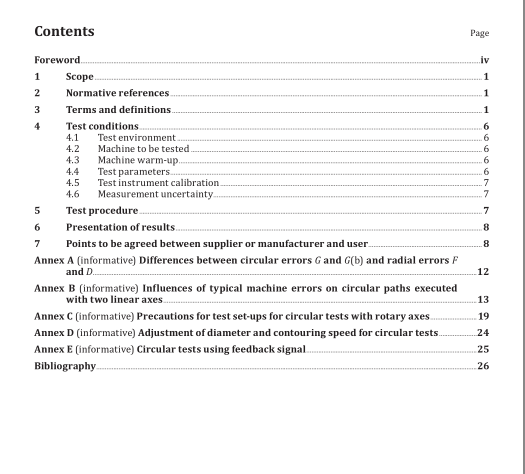ISO 230-4:2022 pdf download.Test code for machine tools — Part 4: Circular tests for numerically controlled machine tools
4 Test conditions
4.1 Test environment
Where the temperature of the environment can be controlled, it shall be set at 20 °C or at the specified reference temperature. If the environment is at a temperature other than 20 °C or other than the specified reference temperature, nominal differential thermal expansion (NDE) correction between the measurement system and the measured object (machine tool) shall be made to correct the results to correspond to 20 °C or to the specified reference temperature (for radial error measurements only).
The machine and, if relevant, the measuring instrument shall have been in the test environment long enough to have reached a thermally stable condition before testing. They shall be protected from draughts and external radiation, such as sunlight and overhead heaters.
4.2 Machine to be tested
The machine shall be completely assembled and fully operational.
All necessary levelling operations and functional checks shall be completed before starting the tests. Unless otherwise agreed between the manufacturer or supplier and the user, the circular tests shall be carried out with the machine in the unloaded condition, i.e. without a workpiece. 4.3 Machine warm-up The tests shall be preceded by an appropriate warm-up procedure, as specified by the manufacturer of the machine and/or agreed between the supplier or manufacturer and the user. If no other conditions are specified, the preliminary movements shall be restricted to only those necessary to set up the measuring instrument.
4.4 Test parameters
The parameters of the test are:
a) diameter (or radius) of the nominal path and – for tests with rotary axis (axes) – radial offset(s) from rotary axis(axes);
b) contouring speed (information on adjustment of diameter and contouring speed for circular tests to keep the axes’ acceleration constant, see Annex D);
c) sense of contouring for circular tests with linear axes, and with rotary axes clockwise or anticlockwise (counter-clockwise) according to 3.8 and 3.9;
d) identification of axes, i.e. machine axes moved to produce the actual path;
e) location of the measuring instrument in the machine tool working zone;
f) temperature (environment temperature, measuring instrument temperature, machine temperature) and expansion coefficient (of machine tool, of measuring instrument) used for compensation for mean bi-directional radial error D and radial error F measurement only;
g) data acquisition method (data capture range if different from 360°, starting and stop points of the actual movement, number of measuring points taken for digital data acquisition and information about filtering, as applicable);
h) any machine compensation routines used during the test cycle;
i) positions of slides or moving elements on the axes which are not being tested.
4.5 Test instrument calibration
For the checking of the mean bi-directional radial error D and the radial error F, the reference dimension of the test instrument (e.g. reference length L B of the ball bar) shall be known.
NOTE For circular tests using a feedback signal, see Annex E.
4.6 Measurement uncertainty
The main contributors to the measurement uncertainty for the bi-directional circular error G(b), the circular error G and the contouring interpolation error E int are:
— measurement uncertainty of the test equipment;
— repeatability of measurement;
— influence of temperature on the machine tool and/or the test equipment, checked, for example, by an environmental temperature variation (ETV) test according to ISO/TR 16015.
The main contributors to the measurement uncertainty for the mean bi-directional radial error D and the radial error F are:
— contributors for the errors G(b) and G (see first list in 4.6);
— uncertainty of the temperature measurement of the machine tool and the test equipment [caused by the uncertainty of the temperature sensor(s) and the uncertainty due to the location of the temperature sensor(s)];
— uncertainty of the thermal expansion coefficients of the machine tool and the test equipment (used for the compensation to 20 °C or to the specified reference temperature).ISO 230-4 pdf download.ISO 230-4 pdf download
